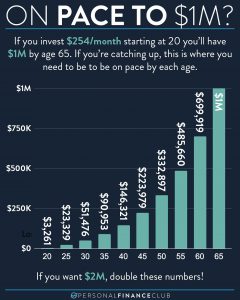
We often talk about expenses on investments in terms of percentages. 0.04%, 1%, 2%. They all seem like small numbers. So I thought it might be interesting to look at the cost in dollars you actually pay based on different percentages.
Fees on investments have this triply nefarious impact. Firstly, you have to pay them each and every year. Second, the fees compound going UP with the value of your investments. Third, all that money you paid in fees in the past represents an opportunity cost for the future. i.e. that money is gone rather than compounding and making your investment even larger.
When I first ran these numbers I was a little bit surprised to see the actual fee paid in the right column to be not that much bigger than the center column, despite the 6% transaction fee and 2% annual fee, the total amount paid isn’t even double the center column. Why? Because the fees are so disastrous to the total value of the investment, they’re taking a larger fee from a smaller amount.
What do you do about this? When you are investing, make sure you understand what fees you are paying. The best way is through a low-cost brokerage, like Vanguard, Fidelity, or Schwab. If you are investing through a financial advisor, make sure you have a very strong understanding of what fees you are paying. Those fees can hide in places like statement fees, annual fees, sweep fees, front loads, back loads, and expense ratios. If you ask your advisor about the fees and they don’t give you a transparent and complete answer, that’s a huge red flag! 🚩🚩🚩
p.s. If you need financial advice, the best way is to find a FLAT-FEE financial advisor. This is an advisor who charges by the hour or the project rather than taking it out of your investments. Flat-fee advisors have historically been hard to find, which is why Vivi, Shane, and I started @hello_nectarine! It’s a site where you can easily book an expert flat-fee fiduciary. No sales pitches, no strings attached. It’s at hellonectarine.com!
As always, reminding you to build wealth by following the two PFC rules: 1.) Live below your means and 2.) Invest early and often.
-Jeremy

 September Sale!
September Sale! 


